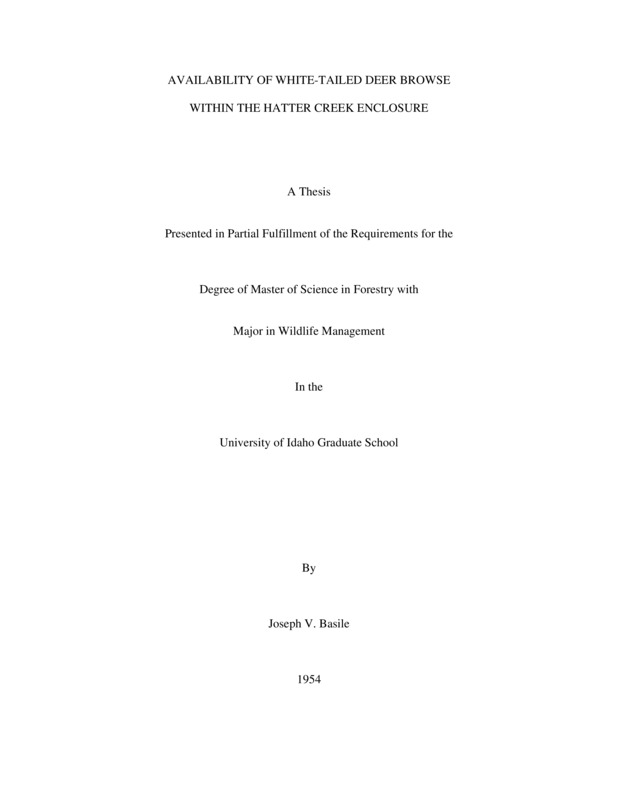PDF PREVIEW
Availability of White-Tailed Deer Browse Within the Hatter Creek Enclosure Item Info
- Title:
- Availability of White-Tailed Deer Browse Within the Hatter Creek Enclosure
- Creator:
- Basile, Joseph V.
- Date Created:
- 1954
- Description:
- A study of white-tailed deer browse was conducted during 1953 and 1954 within the Hatter Creek Enclosure, an 800-acre area devoted to wildlife research and located on the University (of Idaho) Experimental Forest in Latah County, Idaho. A forage inventory was made in which a cover-type map of the area was produced based on an ecological classification of the vegetation. The map depicts the location and size of the area occupied by each of the various success ional stages of vegetation, the zones and habitat types of which these stages are a part, and the dominant species present in the canopy and understory. The percentage of ground cover and the species composition of that cover were determined by the line interception method of sampling vegetation. The shrub species present were divided into two categories according to whether or not they are generally considered to be preferred as browse by white-tailed deer in this area. It was found that the ratio of preferred to non-preferred species varied between cover types, but that the two classes of shrubs were present in approximately equal ratio on the area as a whole. Four of the preferred species (willow, redstem ceanothus, western redcedar, and serviceberry) were studied to determine the effects of snow depths on the availability of browse. These determinations were hampered by mild weather conditions during the winter, and accumulated snow depths of more than 18 inches were rare. The amount of snow on the ground at any time varied considerably between the cover types. Percentages of total browse available with snow covers of approximately 1 foot and 1 ½ feet were as follows: willow, 97.1 and 92.8; redstem ceanothus, 67.4 and 49.3; western redcedar, 55.8 and 54.2, respectively. Percentage differences between species were due to differences in the distribution of current growth among the various height levels of the plants, and in the susceptibility of the branches of these species to bending under the weight of snow. The maximum accumulated depth on the serviceberry plot was 8 inches; the browse on these plants remained 100 percent available. A clipping experiment was initiated to determine the ability of redstem ceanothus to withstand various degrees of forage removal. Three clipping intensities were employed, in each of which forage was removed in amounts that left a predetermined number of buds on each twig, as follows; 0, 1 and 3 buds, respectively. All four plants in each group were subjected to the same treatment. In addition, four plants were unclipped and served as a control group. Each of the clipped plants showed a large gain in linear production and average twig length, as contrasted to a net loss in each of the control plants. Flower production was drastically reduced on the clipped plants, but was normal in the control group. Results are available for only one growing season following the start of the experiment, and are not representative of what may be expected over a period of several years of annual clipping at the same intensities.
- Document Type:
- Thesis
- Library Call Number:
- SD427.G8B3
- Subjects:
- East Hatter Creek white-tailed deer browse browse white-tailed deer ungulates available browse forest resources
- UIEF Unit:
- East Hatter Creek
- Location:
- UIEF; East Hatter Creek
- Latitude:
- 46.834119
- Longitude:
- -116.801181
- Department:
- Department of Forest Resources
- Type:
- Text
- Format:
- application/pdf
Source
- Preferred Citation:
- "Availability of White-Tailed Deer Browse Within the Hatter Creek Enclosure", UIEF Research Exchange, University of Idaho Library Digital Collections, https://www.lib.uidaho.edu/digital/uief/items/uief_0113.html
Rights
- Rights:
- In copyright, educational use permitted.
- Standardized Rights:
- http://rightsstatements.org/vocab/InC-EDU/1.0/

